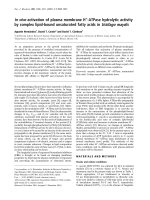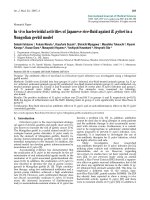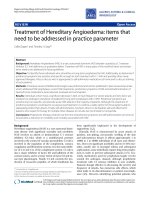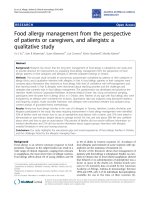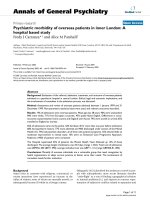Báo cáo y học: "In critically ill patients the procalcitonin level can be misleading" pdf
Bạn đang xem bản rút gọn của tài liệu. Xem và tải ngay bản đầy đủ của tài liệu tại đây (117.02 KB, 2 trang )
ree recently published articles in Critical Care con-
cerning the usefulness of procalcitonin (PCT) in critically
ill patients elicited this cautionary comment of the
present article’s title [1-3]. PCT has been introduced as a
test with high sensitivity and specifi city for bacterial
infection in patients in the emergency department. e
test’s negative predictive value is thought to be suffi cient
to withhold antibiotics in cases of low PCT [4,5]. PCT
has also been evaluated as a diagnostic tool in critically ill
patients. is would be of help because there is no
immediately available test that proves or disproves a
bacterial infec tion. Especially, the number of true and
false negative patients cannot be estimated. We therefore
cannot deter mine the test characteristics of PCT in these
patients. We can determine with more certainty the true
positive patients and measure their PCT level.
Between March 2007 and April 2008 we registered all
patients presenting to the emergency department, the
ICU or wards of internal medicine meeting the criteria of
the Surviving Sepsis Campaign guidelines for severe
sepsis or septic shock. In these patients we measured the
PCT level with the PCT-Q test (Brahms, Henningsdorf,
Germany) at presentation, and microbiological analysis
(blood cultures, sputum cultures and urine cultures) was
performed. Microbiological proven sepsis was defi ned by
a positive blood culture result (except cultures with
Staphylococcus epidermidis) or by positive culture results
other than blood in the presence of two or more systemic
infl ammatory response syndrome criteria.
In the above-mentioned period we included 132
patients. Patient characteristics are displayed in Table 1.
A total of 63 (47%) patients had proven sepsis or septic
shock. Blood cultures were taken in 127 patients, of
which 40 patients (30.3%) were positive. In 101 patients
with blood cultures taken, the PCT level was measured at
presentation (Table 2). irty-two patients had PCT
levels <0.5 ng/ml, of which eight patients (25%) had
positive blood cultures.
Based on these results we conclude that PCT levels can
be misleading. It is unsafe to withhold antibiotics based
© 2010 BioMed Central Ltd
In critically ill patients the procalcitonin level can
be misleading
Jacqueline Koeze
1
*, MG Ron Hendrix
2
, Frank AJTM van den Bergh
3
, René ML Brouwer
4
and Jan G Zijlstra
1
See related research by Karlsson et al., related research by van Nieuwkoop et al.,
and related commentary by Wol and Bouadma, />LETTER
*Correspondence:
1
Department of Critical Care, University Medical Center Groningen, University of
Groningen, Postbus 30.001, 9700 RB Groningen, The Netherlands
Full list of author information is available at the end of the article
Table 1. Characteristics of the 132 patients included in the
analysis
Number of patients (n) 132
Age (years)
a
65.3 ± 1.3
(22.7 to 96.0)
Male (%) 64.4
Survival (%) 74.2
PCT analysis at presentation performed (n) 110
Number of patients with PCT <0.5 ng/ml (n (%)) 34 (25.8)
Number of patients with PCT 0.5 to 2.0 ng/ml (n (%)) 21 (21.2)
Number of patients with PCT 2.0 to 10.0 ng/ml (n (%)) 27 (20.5)
Number of patients with PCT >10.0 ng/ml (n (%)) 28 (21.2)
Number of blood cultures conducted (% positive ndings) 127 (30.3)
Number of sputum cultures conducted (% positive ndings) 24 (33.3)
Number of urine cultures conducted (% positive ndings) 79 (25.3)
Number of pus cultures conducted (% positive ndings) 26 (65.4)
PCT, procalcitonin.
a
Data presented as mean ± standard error of the mean
(range).
Table 2. Procalcitonin results in negative and positive
blood cultures
Blood cultures (n)
Procalcitonin at
presentation Negative Positive Total (n)
<0.5 ng/ml 24 8 32
0.5 to 2.0 ng/ml 16 5 21
2.0 to 10.0 ng/ml 13 10 23
>10.0 ng/ml 12 13 25
Total 65 36 101
Koeze et al. Critical Care 2011, 15:422
/>© 2011 BioMed Central Ltd
on a test with unknown test characteristics, such as PCT,
in patients presenting with criteria meeting the Surviving
Sepsis Campaign guidelines for severe sepsis or septic
shock. Fortunately, the Surviving Sepsis Campaign
bundle is clear on this point and these patients received
appropriate antibiotics in accordance with this guideline.
Abbreviations
ICU, intensive care unit; PCT, procalcitonin.
Competing interests
The authors declare that they have no competing interests.
Author details
1
Department of Critical Care, University Medical Center Groningen, University
of Groningen, Postbus 30.001, 9700 RB Groningen, The Netherlands.
2
Laboratory of Microbiology, Twente Achterhoek, Postbus 377, 7500 AJ
Enschede, The Netherlands.
3
Department of Clinical Chemistry, Medisch
Spectrum Twente, Postbus 50.000, 7500 KA Enschede, The Netherlands.
4
Department of Internal Medicine, Medisch Spectrum Twente, Postbus 50.000,
7500 KA Enschede, The Netherlands.
Published: 28 April 2011
References
1. Karlsson S, Heikkinen M, Pettilä V, Alila S, Väisänen S, Pulkki K, Kolho E,
Ruokonen E; Finnsepsis Study Group: Predictive value of procalcitonin
decrease in patients with severe sepsis: a prospective observational study.
Crit Care 2010, 14:R205.
2. van Nieuwkoop C, Bonten TN, van’t Wout JW, Kuijper EJ, Groeneveld GH,
Becker MJ, Koster T, Wattel-Louis GH, Delfos NM, Ablij HC, Leyten EM, van
Dissel JT: Procalcitonin re ects bacteremia and bacterial load in urosepsis
syndrome: a prospective observational study. Crit Care 2010, 14:R206.
3. Wol M, Bouadma L: What procalcitonin brings to management of sepsis
in the ICU. Crit Care 2010, 14:1007.
4. Bouadma L. Luyt CE, Tuback F, Cracco C, Alvarez A, Schwebel C, Schortgen F,
Lasochi S, Veber B, Dehoux M, Bernard M, Pasquet B, Régnier B, Brum-Buisson
C, Chastre J, Wol M: Use of procalcitonin to reduce patients’ exposure to
antibiotics in intensive care units (PRORATA trial): a multicenter
randomized controlled trial. Lancet 2010, 375:463-474.
5. Kopterides P, Siempos II, Tsangaris I, Tsantes A, Apmaganidis A: Procalcitonin-
guided algorithms of antibiotic therapy in the intensive care unit: a
systematic review and meta-analysis of randomized controlled trials. Crit
Care Med 2010, 38:2229-2241.
doi:10.1186/cc10132
Cite this article as: Koeze J, et al.: In critically ill patients the procalcitonin
level can be misleading. Critical Care 2011, 15:422.
Koeze et al. Critical Care 2011, 15:422
/>Page 2 of 2


